Situated
high on a hill, Montefiascone can be considered to be as
Tuscia's natural observatory. In an area around the town,
called Rocca dei Papi, important archaeological finds were
discovered. Montefiascone territory was settled by ancient
civilizations, such as the Aeneolithic one of Rinaldone.
The town also became the most important southern bulwark
of the Etruscan Velzna (Orvieto) engaged in counteracting
Vulci's and Tarquinia's expansion and in the defence of
the natural provisions ensured by the lake. With the
destruction of Velzna and the sack of the Fanum Voltumnae
in 264 B.C., the Etruscans were annihilated by the Romans.
Other historical events took place in these parts, such as
Amalasunta's death, queen of the Goths, in 535, on the
very island of Martana, the Privilege ratification of Pope
Leo IV, who first mentioned Montem Flasconis in the 9th
century and the meeting between the countess Matilde di
Canossa and Pope Gregorio VII in the Castrum of San
Flaviano to organize a defence against the Normans. The
Castrum of Montefiascone, in fact, proved itself to be
fundamental for the defence of the territory included in
the Patrimonium Beati Petri, and it became the scene of
many battles between the Church and the Roman Empire. This
conflicting situation caused the fortress to be
continuously restructured and fortified. In 1185, Federico
Barbarossa issued a diploma in favour of the town. Otto IV
and Henry VI established the Imperial seat there, making
the town become the southern administrative centre of the
Swabian kingdom. During the conflict, Pope Innocent III
placed there the seat of the Governor of the entire
Patrimonium Beati Petri. Finally, in 1353, Cardinal Egidio
Albornoz decided to restore the authority of the Church on
all the rebellious territories. The Castle became then the
most formidable fortress of the papal army. In 1368 Pope
Urban V remained in Montefiascone giving the town, a year
later, its own diocese. During the following centuries,
popes, kings, saints and artists, such as St. Bernardino
da Siena, Pio II, Cesare Borgia, Giulio II, Michelangelo,
Leo X, Giuliano da San Gallo, Carlo V, Paolo III, visited
the Castle and in 1600, the town enjoyed a period of
cultural magnificence, becoming key both in Italy and
abroad, thanks to the Venetian Cardinal Marcantonio
Barbarigo.
|
 |
Montefiascone
is the ideal place to spend a holiday for those who
love nature, history and art. The preservation of
the territory is ensured by agriculture which is the
main activity of the area. The climate helps a lush
vegetation grow, also thanks to the favourable
influence of the lake.
To the north of Montefiascone, there are thick woods
of Turkey oaks, "roverella" and, up 500
mt., chestnut-tree covered hills. In spring, it is
possible to admire charming patches of yellow from
the broom bushes called "carbonai"
beautifully blending with the green of the
vegetation.
These woods are swarming with an incredible variety
of wildlife including the red and the green
woodpeckers (that nest in of the age-old trees), the
hoopoe, the predatory birds, such as the buzzard,
the owl, the "gheppio", the tawny owl and
the barn owl. Wild boars, porcupines, foxes, badgers,
beech-martens and weasels are also part of this
natural forest.
Blooming cane-brakes grow on the shore, where the
coot, the moor-hen and the mallard build their nests.
By the shores of the lake, poplars, willows and
black alders grow and hosts the nests of the great
crested grebe, the rare "garzetta", and
different species of herons.
The lake is rich in fish: the famous "coregone",
indigenous to the alpine lakes, has made these
waters into an ideal habitat, as well as eels,
mentioned by Dante, pikes, perches, "lattarini",
carps and tenches. Needless to say, fishing is one
of the main activities of the territory.
This is the perfect backdrop for salutary walks and
rides, biking, swimming, sailing, surfing, and
fishing. The area is also perfect for those who
would like to invest their money in the construction
of holiday farms.
Besides, Montefiascone offers well-organized sport
centres with swimming pools and facilities to play
soccer, baseball and tennis.
|
|
Famous
for its wine, Montefiascone has always been appreciated as
a destination for real gourmand.
The traditional "trattorie" and restaurants will
welcome you with their warm hospitality. The best-known
first courses are the "panzanella",
"fettuccine al lansagnolo",
"pappardelle", "lasagne" and exquisite
soups, such as "pasta e fagioli", "pasta e
ceci", rice with lentils, and the famous "acquacotta",
a simply-made, delicious "country soup".
The second courses are based on freshwater fish, including
the delicious Bolsena eel, the coregone and the lattarini,
matched to your pleasure with saltwater fish to create a
refined combination of flavours.
As for meat base dishes, one of the favourites is the lamb
cooked in different ways, such as "scottadito",
"cacciatora" and "bujone".
Unforgettable are also the pigeon, the rabbit "alla
cacciatora", chicken, game, the noted ossobuco and,
last but not least, the typically Italian tripe with sauce.
All is washed down with DOC quality wine, the dry one
having a bright gold-yellow colour, a delicate scent and a
sort of sweet-bitter taste, perfect with hors-d'oeuvres,
also the "asciutte" and fish. The sweet wines
are straw-coloured and with a taste like grapes, perfect
with desserts. Bonaventura Tecchi wrote about this wine:
"Few wines like the Montefiascone, echoing the
triple crescendo of c'è, c'è, c'è (there's a wine!),
seems to capture, especially in the mind of those who are
away from home, the pleasures of life, the warmth of the
earth and the sun, a vision of gayety and confidence,
resplendent in lands forever happy. All wines, everybody
knows, are the fruit of an incredible matrimony between
earth and sky; they are almost a leap of the earth towards
the heavens, a descent of angels among men. And I believe
that even fewer wines retain the robustness of this union.
Ours is one of these".
During the first half of
August, the yearly "Wine feast" is organized in
order to promote the typical quality wine Est! Est!!
Est!!!. The initiative takes place in the public garden at
the heart of the town and continues in the historic
quarters with a tour called "In the cellars with
Defuk", dedicated to wine and to the exquisite local
specialities offered inside old cellars.
|

